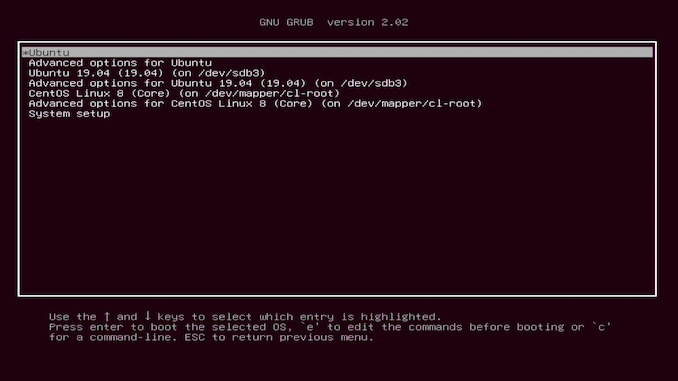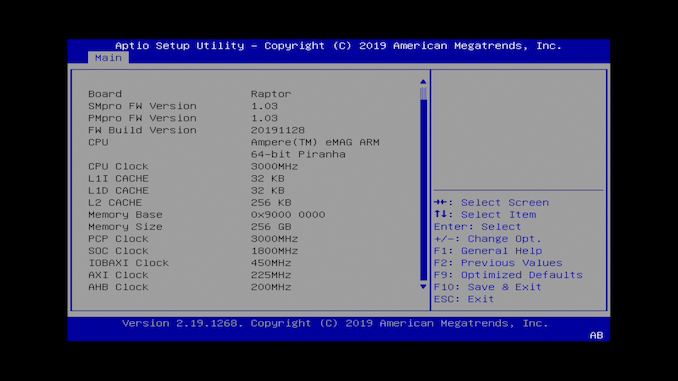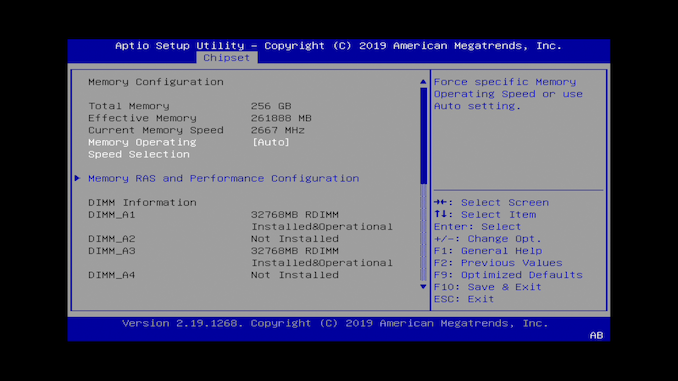Avantek's Arm Workstation: Ampere eMAG 8180 32-core Arm64 Review
by Andrei Frumusanu on May 22, 2020 8:00 AM ESTAn Arm SBSA System
As noted, the one thing that sets the eMag Workstation apart from most other Arm-based embedded systems in the market, is the fact that it’s an SBSA (Server Base System Architecture) compliant system.
What SBSA mandates as a standard, is for a vendor to design the hardware in a certain way such that the CPU, the system timers, interrupts and PCIe handling operates in such a way, that any SBSA compliant operating system image would be able to boot on it.
That’s in stark contrast with most other Arm embedded systems in the market – take Nvidia’s Jetson Arm development kits: while these system do have images for popular OSes such as Ubuntu, these are provided and maintained by Nvidia, with customised kernels and baked-in drivers. You’re reliant on the vendor to actually update the OS images, lest you actually go ahead and compile your kernels and OS yourself – if possible at all.
An SBSA system on the other hand will be able to boot generic OS images – essentially the same way it would work on any x86 desktop or server system on the market.
In essence, that’s the one main advantage of the eMAG Workstation over any other Arm embedded system, and it’s a strong advantage from a software standpoint.
The system has a comprehensive BIOS with tons of configuration options. The options here match and exceed what you’d find in a typical x86 system – overclocking options aside of course.
One important aspect of the system is that this is a server motherboard with a BMC. The BMC is an ASPEED AST2500 chip that allows independent management of the system through the dedicated BMC Ethernet port on the back of the system, allowing for two BIOS images to be set and configured.
It also serves as the 2D driver allowing for (non-accelerated) VGA display output via the D-Sub connector on the back of the system. There’s also a serial connection for terminal access.
One big disadvantage of the BMC nature of the system and the SBSA architecture, is that boot times are horrible. Booting and rebooting the system is a matter of test of patience with each cycle taking between 4 to 5 minutes, as demonstrated in the above video capture. The BMC bootup itself is around 1:20 minutes before we get to the BIOS screen, and then another painful 3 minutes for Linux to actually boot up to the login screen. The ecosystem still has a lot of work ahead to optimise this aspect of Arm systems.





















35 Comments
View All Comments
SarahKerrigan - Friday, May 22, 2020 - link
The X-Gene microarchitecture was never particularly stellar and by the time eMag rolled around it was woefully obsolete. I did some testing on eMag a few months back and it was pretty dire. When I spent some time on Graviton2 last week, it was like night and day compared to eMag (frequently 2+ times the single-thread perf despite a much lower clock), so I have high hopes for Altra.SarahKerrigan - Friday, May 22, 2020 - link
By the way, Andrei, you may want to correct the ST SPECFP subtest result graph - it looks like you used Graviton as a template and forgot to change the labels to eMag, because right now it only mentions Graviton1, and Graviton2, and Intel, not eMag.Andrei Frumusanu - Friday, May 22, 2020 - link
Thanks, good catch.Flunk - Friday, May 22, 2020 - link
Interesting to see even if this hardware only makes sense for very specialized purposes. ARM processors have gone from only applicable to mobile devices to something that would have made sense in a server a few years ago.SarahKerrigan - Friday, May 22, 2020 - link
This isn't exactly a good representative of ARM processors; chips like Graviton2 are competitive for server workloads today, and make eMag look like a toy by comparison.eastcoast_pete - Friday, May 22, 2020 - link
Thanks Andrei, good and in-depth review! You and others here have already commented on the great difference of this legacy CPU to Ampere's Altra or Amazon's Graviton 2. What I am also very curious about is Fujitsu's ARM-based multicore CPU (A64FX). Amongst other features, it supports 512-bit scalable vector extensions (SVEs), so same width as Intel's AVX512. I wonder if someone at Fujitsu reads Anandtech, and maybe send you a setup for review, although a PRIMEHPC might be out of the scope here. Still, that's an ARM v8 design that should beat the Graviton 2 and the Altra, especially if applications can make use of the wide SVEs.anonomouse - Friday, May 22, 2020 - link
Based on what we know of the A64FX, it’ll almost certainly *only* beat Graviton 2/Altra in cases where it can heavily utilize wide vectors. In all other scenarios it really doesn’t have a lot of execution width, and only runs at 2.2Ghz. The disclosures in their Microarchitecture guide also don’t showcase anything impressive looking on the branch predictor, which is fine for the typical HPC workloads it will run. That thing is very heavily purpose designed for HPC, and it’s clear they focused on that and not general performance.SarahKerrigan - Friday, May 22, 2020 - link
Indeed. It's a specialized chip. I would expect no miracles from it on general-purpose loads.eastcoast_pete - Friday, May 22, 2020 - link
Agree with you and anonomouse on general purpose loads; my interest in wide vectors is mainly due to their utility for video processing and encoding, if (!) the software supports it. For those applications, AVX512 is what keeps Intel competitive with EPYCs in the x64 space. As a question, is anything like an AV1 encoder even available for ARM v8, and specifically to use wide SVEs?Wilco1 - Saturday, May 23, 2020 - link
There are many AV1 codecs which have AArch64 optimizations, but most focus on older mobile phone cores (eg. http://www.jbkempf.com/blog/post/2019/dav1d-0.5.0-... ), so likely need further work on latest microarchitectures with up to 4 128-bit Neon pipes.It's early days for SVE, the first version (as in A64FX) is aimed at HPC. Video codecs will be optimized for SVE2 when hardware becomes available.